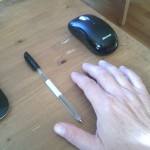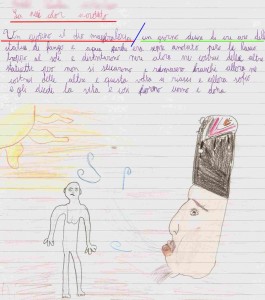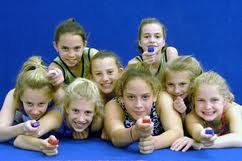 TAGteach goes international
TAGteach goes international
Around the world people are using TAGteach to help children and adults learn new skills.
This article comes from Luca Canever, an educator and Level 3 TAGteacher from Verona, Italy. He shares his knowledge, dedication and love of positive reinforcement techniques at his website, TAGteach Italia.
Luca tells how he came up with great reinforcement ideas for his entire class (group reinforcement!), and how he used TAGteach to help students with specific problem areas. Here is his story.
TAGteach at school: Reinforcing the group
Managing the reinforcement for a group of people is one of the major difficulties that we may encounter. Especially if the people in question are 20 kids, 11 years old, with interests and personalities different from each other.
For the last two months I’ve been working in a school as a teacher. For the first time, I have the chance to use the marker with a large group — a group with no particular desire to be at school! How can we reinforce them? Some of the kids enjoy candies, some others like beads or extra time for recess. There are (they exist!) students who find study itself reinforcing, but, they are very, very, very rare.
What I have decided to do is to take a continuous rotation between different schedules of reinforcement: today we work for extra time for recess; tomorrow we will earn beads and bracelets; after we will earn points for watching a movie, or to enjoy some favorite activity. It may seem an insurmountable obstacle and demoralizing at a first glance (if you do not find the suitable reinforcer, the worst can happen) to find reinforcers suitable for a group of people. I think it could be done with a little of imagination and desire to come up with new strategies. And if, for once, it does not work … amen. The more we become able to grasp behaviors to reinforce the easier it will be to reinforce these behaviors.
I used TAGteach in different situations; and even if I’m not using the marker, the principles of the methodology are always present (or at least I hope so…).
TAGteach for Writing Skills
PEN HOLDING: Many students have a wrong pen holding habit. This can cause problems with the joints of the wrist, and difficulty in writing that could translate into, “I do not like to write,” or “I cannot write.” So if we want to educate future Shakespeares properly, holding the pen in your hand is the first step.
In this case I used two tag points:
- Squeeze your thumb and forefinger
- Push with the middle finger
The pen must be taken between thumb and forefinger and then it should rest on the middle finger. I found two good targets for these behaviors on YouTube.

First: put the pen on the table with the tip facing you.
Second: use the index and middle fingers of the left hand to position thumb and index of the writing hand to the correct height on the pen: exactly on the edge indicated by the index finger. The two photos show the two targets.
TAGteach for cursive writing and improving cognition
DYSGRAPHIA: One of my boys has some (fortunately light) cognitive problems. He writes in a disorderly manner and has few skills in the area of the working memory. Instead of using some fallback strategies such as writing in capital letters or writing with the computer, I decided (respecting the personality and the expertise of the student), to have him write in cursive. I started with a tag point “Letters on Line,” to improve correct writing.
 The picture shows the first session we had. The red line shows his “standard” writing. Notice all those ups and downs? The blue line shows where I started marking (tagging “Letters on Line). The tagging session lasted throughout the green line. Then he continued on his own.
The picture shows the first session we had. The red line shows his “standard” writing. Notice all those ups and downs? The blue line shows where I started marking (tagging “Letters on Line). The tagging session lasted throughout the green line. Then he continued on his own.
The difference is immediately obvious. 15 days after this intervention, the writing is still stable on the line, without me having to do other sessions. Not only that. I noticed that the way the boy is able to organize his thoughts for writing is becoming more streamlined and flowing — as if being able to write in order helps him think in order.
TAGteach for reading
READING SKILLS: Punctuation is not something that my kids are confident with. But reading with expression helps with understanding the text; and the positive experience of reading, according to the motto that I’ve just invented is, “If you can read, then you like to read.” Reading without difficulty means having the skills to study better, faster and more profitably.
So I started to teach how to respect the pauses of punctuation with peer tagging. In peer tagging, two students work together from the same material. The exercise took place as follows: the first student reads, the second student tags his correct reading of punctuated text. The first tag point is “breathe on commas.” But it could be, at the next level, “Respect the punctuation,” or “Pause on dots,” etc., etc.). After five tags the second peer starts reading and is tagged by the next student. That’s if you want the whole class to follow along. If you want to liven it up, just form groups of two or three students, setting shifts for the reader and for the markers–the kids doing the tagging!
A big thank you!
Thank you Luca, for sharing your successes with TAGteach in the classroom! I really enjoyed your descriptions of how you used TAGteach with academic skills. With your cursive writing student, it was very interesting to see how writing properly helped his thinking process. Also with this student, it was amazing to see how such a short intervention with positive reinforcement had such a lasting impact!
We look forward to hearing more.
What is TAGteach?
TAGteach stands for Teaching with Acoustical Guidance. TAGteach is a teaching and communication method based on the scientific principles of Applied Behavior Analysis (ABA).
TAGteach enables extremely precise positive reinforcement of behavior by using an acoustical signal to “mark” the behavior – at the precise moment the child performs the behavior! The acoustical signal is a short, sharp sound made by a handheld device (the “tagger”). When the child performs the correct action, the parent/instructor immediately presses the button on the tagger and hands over a treat (candy, treat, token, praise, social recognition, or money) as a reinforcer.
With TAGteach, it is easy to reinforce behaviors precisely and quickly. The immediate, accurate feedback and positive reinforcement result in the child performing the correct action more often, and for longer periods of time. With immediate feedback and learning tasks broken down into small steps, children can learn many new skills with TAGteach — at their own pace.
 Check out the TAGteach International website.
Check out the TAGteach International website.
Join the free TAGteach listserve.
TAGteach taggers are available here.
See book about TAGteach for Autism or ask a question (with no obligation).
Sign up for my mailing list to receive updates, new articles and free tips right in your inbox!
If you liked this post, please share it on social media via the vertical gray menu on the far right. Thank you!
